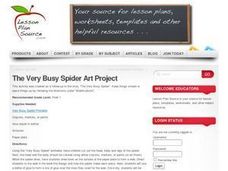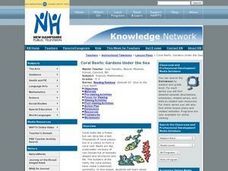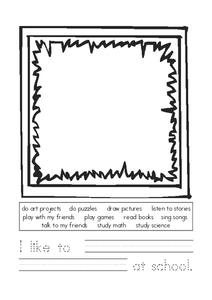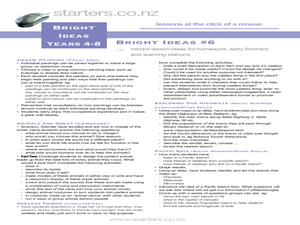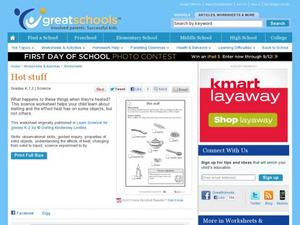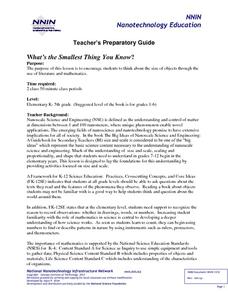Curated OER
The Very Busy Spider Art Project
Students listen to the story The Very Busy Spider and participate in an art activity related to the book. In this story inspired art lesson, students use a Very Busy Spider printable and cut out the spider's body and connect...
Curated OER
An Introduction to Simple Machines
Students investigate simple machines and their uses in everyday life. In this scientific method instructional activity, students examine physical tools such as wedges, screws, and levers using a "how does it work" approach....
Curated OER
Importance of Fresh Vegetables and Fruits in Our Diets
Students explore the importance of fruits and vegetables in our diets. In this science lesson, students discuss various types of fruits and vegetables. Students play the good health=good diet game. Students discuss types of fruits and...
Curated OER
Coral Reefs: Gardens Under the Sea
Students discover the wonders of coral reefs while listening to a book about them. In a Reading Rainbow video activity, they simulate a dive, check equipment and explore a reef. Role-playing as marine biologists, students uncover...
Curated OER
Popcorn
Learners discuss the properties of popcorn. They explore the connection between corn, popcorn and Thanksgiving. As a class, students sing a popcorn song and create a popcorn craft. They practice writing the word popcorn. As a...
Curated OER
Water Works Wonders
Students examine where water is found in the world, how we use it, and the various forms it takes. They observe the refraction of light through a prism, record the day and night sky over a week's time, and create a topographic model of...
Curated OER
Easter Egg Math
First graders apply logic and reasoning skills to solve math word problems. Using four colored paper eggs and four names, they try to soilve the logic puzzle by matching a name with a favorite color. Students check their answers on the...
Curated OER
Favorite School Activities
In this language arts worksheet, students examine the choices of favorite school activities and write a choice in the lines provided.
Curated OER
Bright Ideas #6
Young scholars complete activities as extra time, learning stations, or homework activities. In this extra time lesson plan, students may complete the activities for visual arts, language skills, and social sciences. Young scholars...
Curated OER
Children's Literature Across the Curriculum Ideas: Chickens Aren't the Only Ones
Students read Chickens Aren't the Only Ones by Ruth Heller. They complete a variety of cross-curricular activities surrounding the study of animals that come from eggs. Included are reading, art, math, science, writing, social studies,...
Curated OER
Count on Science & Math for Your Future
Young scholars complete a variety of classroom and online activities designed to teach them the importance of science and math in all career paths and stimulate their awareness and interest in various careers.
Curated OER
Valentine Candy Count
Students analyze a bag of Valentine candy to create a graph. In this graphing lesson, students make predictions, sort by color, record data and make a graph. Students discuss results and make generalizations. Students generate their own...
Curated OER
Plants have needs, too!
Plants can die if they don't get enough sunlight and water. Kindergartners observe a picture of a hanging plant and grass under a tree, and interpret which each plant has died. Next, they grow watercress seeds in wet cotton to compare...
Curated OER
Growing
Growing is part of being a living thing. Kindergartners decide which illustrations represent the life cycle of a living thing, then put a check mark next to the correct pictures. They then examine their own growth on a height chart.
Curated OER
Ring-A-Ding-Ding!
What sound does metal make when you hit it? Kindergartners and first graders conduct an experiment about the properties of metal. First, they draw a line between metal items and descriptions of each. Next, they use a magnet to see which...
Curated OER
Hot Stuff
Very young scientists who are learning about solids, liquids, melting, and freezing will use this worksheet to identify things that would melt if put in a warm place. There are eight objects altogether, and learners place a check mark...
Baylor College
Do Plants Need Light?
Turn your classroom into a greenhouse with a lesson on plant growth. First, investigate the different parts of seeds, identifying the seed coat, cotyledon, and embryo. Then plant the seeds and watch them grow! Measure the new plants...
Curated OER
Reflection of Light
Young scholars experiment with reflections of two plane mirrors placed at a 90 degree angle to see what will be reflected.
Curated OER
ABC and 1-2-3 Farming
Students demonstrate how to alphabetize animal names. In this word study lesson, students identify animals that live on the farm and conduct a favorite farm animal survey. Students order animal pictures in alphabetical order.
Baylor College
How Do We Use Water?
Send youngsters home to survey how they use water in their homes. Then bring them together to discuss which uses are essential for our health and which are not. A helpful video offers teaching tips for this lesson, and a presentation...
National Nanotechnology Infrastructure Network
What’s the Smallest Thing You Know?
Elementary learners listen to a story, then sort objects from largest to smallest at six different stations around the classroom. Adaptable for a large range of age and ability groups.
Curated OER
What is Physical Fitness?
First graders explore and discuss what physical fitness actually is, its benefits and how to obtain it through a variety of ways. They summarize the five parts of physical fitness: cardiovascular endurance,muscular strength, muscular...
Curated OER
Shapes and Tools
Young learners view different shapes drawn by the teacher on the board. The teacher identifies each shape by name and discusses the importance of knowing the difference between shapes when building something. The pupils complete the...
Advocates for Human Rights
The Right to a Clean Environment: Water
First, young citizens learn about water consumption by doing some research themselves on their home water usage and sharing their findings with the class. Then, they do some brainstorming and devise a plan to reduce water consumption.
